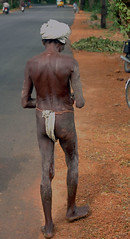Life is to share. With the grace of the Guru, meditate and fill your life with light, love and laughter. Find fulfilment that you were useful to the world and to your Guru in a small way.
Tuesday, 14 November 2006
The Kaupinam
Kaupina in Indian Culture
Kaupina features often in Indian literature.
Sri Shankaracharya has written a poem containing five verses on praising the Kaupina called Kaupina Panchakam
. It is considered to be one of the highest Vedantic text of dispassion for the Sadhaks.
Kaupina is the attire of Lord Shiva, and sadhus who worship him wear the kaupina as the sole clothing as they beg or meditate.
In the recent times, Bhagavan Ramana Maharshi, a great Mahatma, used only a Kaupina as he walked around Arunachala hills in Thiruvannamala.
A part of the Hindu initiation ceremony involves teaching the boys how to wear the kaupina.
You will also see many drawings and temple sculptures with people wearing just a kaupina.
Labels:
culture,
happy life,
life incidents,
life is like that,
mahatma
Subscribe to:
Post Comments (Atom)


No comments:
Post a Comment